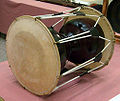This article includes a list of references, related reading, or external links, but its sources remain unclear because it lacks inline citations .(July 2024) |

Traditional Korean musical instruments comprise a wide range of string, wind, and percussion instruments.






